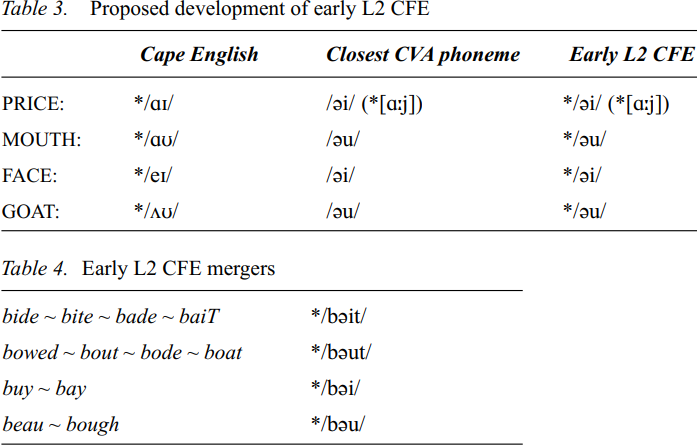


 Grammar
Grammar
 Tenses
Tenses
 Present
Present
 Past
Past
 Future
Future
 Parts Of Speech
Parts Of Speech
 Nouns
Nouns
 Verbs
Verbs
 Adverbs
Adverbs
 Adjectives
Adjectives
 Pronouns
Pronouns
 Pre Position
Pre Position
 Preposition by function
Preposition by function 
 Preposition by construction
Preposition by construction
 Conjunctions
Conjunctions
 Interjections
Interjections
 Grammar Rules
Grammar Rules
 Linguistics
Linguistics
 Semantics
Semantics
 Pragmatics
Pragmatics
 Reading Comprehension
Reading Comprehension|
Read More
Date: 31-3-2022
Date: 23-3-2022
Date: 2024-05-07
|
Research on CFE carried out by Finn (forthcoming) attempts to gain a better appreciation of how substratum effects can lead to language change in a situation of language shift, by taking better cognizance of the complex role of second-language acquisition processes – embodied in the concept of interlanguage that such a scenario implies.
Auditory analysis of audiotaped data collected in Cape Town indicates the existence in CFE of a type of ‘Canadian Raising’ (CR), whereby the onsets of closing diphthongs of the PRICE and MOUTH classes are centralized in pre-fortis environments but low elsewhere:

Trudgill (1986: 153–161) plausibly attributes the rise of CR in Canadian and other varieties of English to the reallocation, according to the phonetic principle of prefortis clipping, of low- and centralized-onset PRICE and MOUTH variants originating in different dialects of English. My claim is that the development of Canadian Raising in CFE similarly involved the interaction of variants originating in different varieties – but in this case the varieties were different distinct languages (English and Afrikaans), instead of varieties of the same language (English). It is proposed that the direct substitution of Afrikaans for English closing diphthongs in the early Afrikaans-English interlanguage adversely affected intelligibility, since quality and quantity contrasts required in the target language were not made, as the following tables make clear:

It is argued that the CR pattern arose after learners utilized L1 length distinctions between ‘pure’ diphthongs and vowel-glide clusters – a process necessarily involving reanalysis of L1 phonotactic restrictions. CVA word-final /ɑ:j/ more closely resembles Cape English word-final [ɒ:ɪ] than does /əi/, in terms of onset quality and quantity. Preferential substitution distinguishing BUY ~ BAY will provide the key to the wider merger problem – as long as learners violate their L1’s phonotactic rules by extending /ɑ:j/ substitution to cover not just word-final environments, but also pre-lenis ones (as in BIDE). Once this is achieved, BITE with [əi] will be clearly distinguished from BIDE with [ɑ:j] in terms not only of actual onset duration, but also of a CR-type difference in onset quality. It is proposed that the durational differential principle is then extended in turn to the MOUTH set, where a CR distinction is similarly set up, and then to the FACE and GOAT sets.
The evidence suggests CR in CFE is indeed an interlanguage feature – since no superior alternative explanations, such as local interaction of purely British English dialects, or of universal language principles, could be found. The presence of CR in all forms of CFE, as well as its continued salience at the latest stage of entrenchment as an L1 in cases of longer-term intergenerational shift from CVA, provides at least some support for the hypothesis that IL features can be shown to play a role in shift-induced language change.
|
|
|
|
تفوقت في الاختبار على الجميع.. فاكهة "خارقة" في عالم التغذية
|
|
|
|
|
|
|
أمين عام أوبك: النفط الخام والغاز الطبيعي "هبة من الله"
|
|
|
|
|
|
|
المجمع العلمي ينظّم ندوة حوارية حول مفهوم العولمة الرقمية في بابل
|
|
|